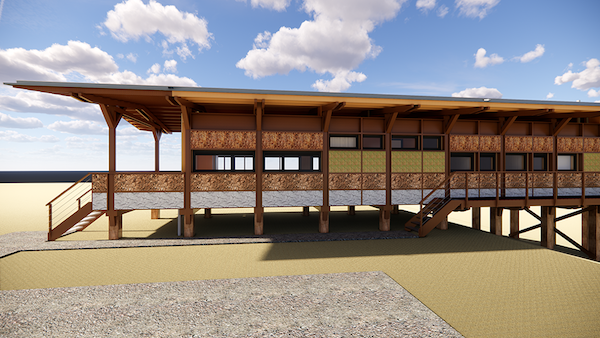Construction of new Field Station in Grenspark Groot Saeftinghe in full swing
- 26 January 2022
- Francien Horrevorts
- Field Station
On January 18, 2022, the first prefab parts of the new field station in Grenspark Groot Saeftinghe were delivered. As a result, the field station is taking shape. This field station will replace the old summer residence, which could no longer be restored. The field station is being built at a unique location in one of the largest brackish water marshes in Europe.
Due to the arrival of the new field station, research by Stichting het Zeeuwse Landschap and research partners in Het Verdronken Land van Saeftinghe can continue. Various monitoring and research activities can continue to take place from this location and new ones are started. This is important for mapping and preserving the biodiversity in Saeftinghe. The collected data also make an important contribution to international knowledge about the value of the tidal area, salt marsh formation and migratory birds.
Activities
The field station will primarily be used as a research station for Stichting Het Zeeuwse Landschap. The researchers mainly conduct research in the field of ecology, archeology and morphology. Bird ringers can also get to work here. As a bird ring location, the field station is an important link within a network of European ring stations because of the bird migration that passes Saeftinghe. The field station is also used as a location for monitoring (breeding) birds. These insights are important for the management of Saeftinghe.
The field station also offers possibilities for limited excursions and public activities in the unique environment. The excursions “Naar de Noord” (a sheepfold in Saeftinghe), which Het Zeeuwse Landschap organises on a small scale, will start here. Due to the restrictions of natural law and regulations, the number of excursions is limited. There are also ideas for an open day on bird ringing.

Photo: RO&AD Architecten
Natural design
The design of the field station takes the natural environment into account. For the construction of the facades, reed, loamy riverbank sand, rubble and stacked turf from the region is used. These natural facades provide the basic needs for insects such as bees, spiders and butterflies. The roof is planted with stonecrop, a plant that traditionally can be found in the area.
Sustainable building materials
When selecting the building materials for the field station, a circular line of thinking was used. A large part of the wood was used in previous Zeeland building projects. The piles used as foundations were previously used at the Weugkade in Vlissingen. Also, the window frames are made of wood from a former staircase from the dunes of Westkapelle and scaffolding at the Arne Canal. And the wood of a former staircase from dunes of the Municipality of Veere has been reused in the floor and the stairs.
Building without impact
To limit the ecological impact of the construction, it was decided to build outside the bird breeding season. Furthermore, the ecologists of the Stichting Het Zeeuwse Landschap have determined in advance where the rare sea aster bee and the sea aster epeolus nest in the area so that they are also protected during the construction of the field station.
To further reduce disturbance to the environment, prefab components are used. This ensures a considerably shorter construction time on site and less transport through the area. The building materials are of sustainable origin. For example, recycled hardwood piles are used and the facades are fitted with cassettes filled with natural materials. The field station is expected to be ready in May 2022.
Partners
The field station is the result of a collaboration between the Province of Zeeland, Grenspark Groot Saeftinghe, Stichting Het Zeeuwse Landschap, Van Hese Infra and RO&AD Architecten. The construction of the field station Is financially supported by Interreg 2 Seas Mers Seas Polder2C’s and a contribution from the Nationale Postcode Loterij.
